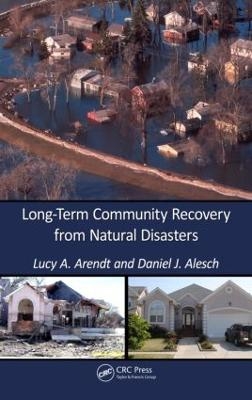
Long-Term Community Recovery from Natural Disasters
Crc Press Inc (Verlag)
978-1-4665-9302-2 (ISBN)
Long-Term Community Recovery from Natural Disasters presents what the authors have learned over two decades from more than two dozen community disasters in and outside the United States. Based on their experiences, they provide a set of practical, cost-effective steps for both reducing the consequences of extreme natural hazard events on communities and for facilitating community recovery.
To achieve long-term recovery, it is essential that we understand how communities develop and/or decay in the absence of an extreme natural hazard event. Then, by recognizing how these events disrupt "normal" development and change, we can determine which parts of the community have to become reestablished or made more functional so that the community can achieve long-term viability. The authors explain how this appreciation of community dynamics and the consequences of extreme natural hazard events enables us to identify those critical points for policy intervention at appropriate levels of government. The combined practical and philosophical insight presented in this book will be valuable not only to policy makers but to scholars as well.
A professor of management, Lucy A. Arendt’s research into planning and decision making spans more than two decades. Her interest in decision making in the wake of extreme natural hazard events led to a conviction that the best way to facilitate recovery is to engage in pre-disaster planning that engages a diversity of stakeholders and that builds collective efficacy and yields action intended to mitigate the consequences of disaster. This book integrates her thinking and research on human action and inaction when faced with the devastating consequences that result from the collision of extreme natural hazard events and human decisions. A former senior social scientist with RAND, where he focused on urban phenomena, and, more recently, as a professor of public administration and planning, Daniel J. Alesch has become a seasoned, skilled student and analyst of disasters, disaster recovery, and disaster mitigation strategies and policies. In this book, he brings what he has learned over more than three decades of field experience, including multi-year analyses of each of more than two-dozen communities as they struggled with the immediate and long term consequences of an extreme natural hazard event.
The Problem. Purpose and Approach. A Basic Consideration. Specification. Two Vignettes: The Makings of a Disaster. From Extreme Natural Hazard Event to Community Disaster. Social Definitions, Experiential Congruence, and Initial Consequences. Metrics and Extreme Natural Hazard Events. What, Then, Is an Extreme Natural Hazard Event? Communities as Complex, Open, and Self-Organizing Social Systems. Meaning of "Complex," "Open," and "Self-Organizing". And Then, a Great Disturbance. Categorizing Consequences. Real Problems for Real People in Real Places. Postdisruption: Real Problems for Real People in Real Places. The Local Economy May Unravel. Housing and Rebuilding Issues. Postevent Demographic Changes. Social and Psychological Consequences. Impacts on Local Government. Workload and Employee Stress. The Building Department as an Example. Unmet Expectations and New Roles. Conflicting Demands between Home and Work. Consequences of Employee Stress. Diminished Revenue Base. Expenses and Shortages. Funding for Long-Term Recovery. Community Disaster Recovery: Definition, Processes, and Obstacles. What Constitutes Community Recovery? Community Recovery Processes. Will It, Can It, Ever Be the Same? Variables That Impede or Facilitate Recovery. Facilitating Recovery. Who’s in Charge? First Things First. Assessing the Nature and Extent of the Consequences. Ensure That Local Government Is Up to the Demands That Will Be Placed on It. Devise a Local Recovery Strategy. Ensure Two-Way Communication. A Recovery Starting Point. Shaping the Postevent Community Trajectory: Rebuilding or Restoring the Economy. Seven Strategies. Pitfalls to Avoid. What to Do before the Next Disaster. Prerequisites for Taking Precautions against Risks Associated with Extreme Natural Hazard Events. Other Concerns: Moral Hazard, Learned Helplessness or Dependency, and Political Opportunism. Goals and Means for Mitigating the Risks Associated with Extreme Natural Hazard Events. Things to Do Now, before the Next Disaster. Index.
| Zusatzinfo | 2 Tables, black and white; 47 Illustrations, black and white |
|---|---|
| Verlagsort | Bosa Roca |
| Sprache | englisch |
| Maße | 156 x 234 mm |
| Gewicht | 566 g |
| Themenwelt | Naturwissenschaften ► Biologie ► Ökologie / Naturschutz |
| Naturwissenschaften ► Geowissenschaften ► Geologie | |
| Naturwissenschaften ► Geowissenschaften ► Geophysik | |
| Sozialwissenschaften ► Politik / Verwaltung ► Staat / Verwaltung | |
| Sozialwissenschaften ► Soziologie | |
| ISBN-10 | 1-4665-9302-4 / 1466593024 |
| ISBN-13 | 978-1-4665-9302-2 / 9781466593022 |
| Zustand | Neuware |
| Haben Sie eine Frage zum Produkt? |
aus dem Bereich


